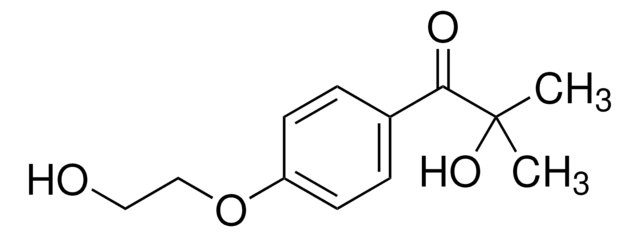729094
Poly(ethylene glycol) diacrylate
average Mn 10,000, acrylate, MEHQ as inhibitor (may contain)
Sinônimo(s):
Polyethylene glycol, PEG diacrylate
About This Item
Produtos recomendados
Nome do produto
Poly(ethylene glycol) diacrylate, average Mn 10,000, contains MEHQ as inhibitor
Formulário
solid
Nível de qualidade
peso molecular
average Mn 10,000
contém
MEHQ as inhibitor
≤1,500 ppm MEHQ as inhibitor (may contain)
adequação da reação
reagent type: cross-linking reagent
reaction type: Polymerization Reactions
temperatura de transição
Tm 60-64 °C
Mw/Mn
<1.1
Ω-final
acrylate
α-final
acrylate
arquitetura do polímero
shape: linear
functionality: homobifunctional
temperatura de armazenamento
−20°C
cadeia de caracteres SMILES
OCCO.OC(=O)C=C
InChI
1S/C8H10O4/c1-3-7(9)11-5-6-12-8(10)4-2/h3-4H,1-2,5-6H2
chave InChI
KUDUQBURMYMBIJ-UHFFFAOYSA-N
Procurando produtos similares? Visita Guia de comparação de produtos
Categorias relacionadas
Aplicação
- 3D Bioprinting of Hydrogels: This study explores the formulation of PEGDA-based hydrogels for 3D bioprinting, focusing on rheological properties and structural fidelity, particularly relevant for tissue engineering applications (Wu et al., 2018).
- Sustained Ocular Drug Delivery: Investigates the delivery of small and large drug molecules using PEGDA implants, highlighting the implications for sustained drug release in ocular therapies (McAvoy et al., 2018).
- Tissue Engineering Scaffolds: Evaluates PEGDA-polycaprolactone scaffolds for tissue engineering, emphasizing the control over porosity and its importance for regenerative medicine applications (Kotturi et al., 2017).
- Photocrosslinked Hydrogel Implants: Focuses on photocrosslinked PEGDA implants for drug delivery, providing insights into the design of drug delivery systems that can be finely tuned for specific therapeutic needs (Qin et al., 2015).
- Hydrogel-Based Artificial Muscles: Characterizes PEGDA/acrylic acid hydrogels optimized for use as artificial muscles, highlighting their potential in biomedical engineering and smart materials (Browe et al., 2017).
Nota de preparo
Palavra indicadora
Danger
Frases de perigo
Declarações de precaução
Classificações de perigo
Eye Dam. 1 - Skin Irrit. 2 - Skin Sens. 1
Código de classe de armazenamento
11 - Combustible Solids
Classe de risco de água (WGK)
WGK 1
Ponto de fulgor (°F)
Not applicable
Ponto de fulgor (°C)
Not applicable
Escolha uma das versões mais recentes:
Já possui este produto?
Encontre a documentação dos produtos que você adquiriu recentemente na biblioteca de documentos.
Os clientes também visualizaram
Artigos
Devising biomaterial scaffolds that are capable of recapitulating critical aspects of the complex extracellular nature of living tissues in a threedimensional (3D) fashion is a challenging requirement in the field of tissue engineering and regenerative medicine.
Global Trade Item Number
| SKU | GTIN |
|---|---|
| 729094-1G | 4061835563777 |
Nossa equipe de cientistas tem experiência em todas as áreas de pesquisa, incluindo Life Sciences, ciência de materiais, síntese química, cromatografia, química analítica e muitas outras.
Entre em contato com a assistência técnica









